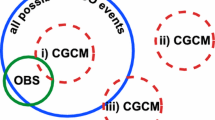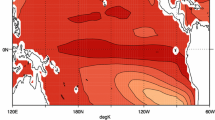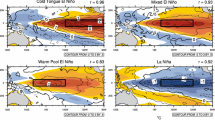Abstract
As in the observed record, the termination of El Niño in the coupled IPCC-AR4 climate models involves meridional processes tied to the seasonal cycle. These meridional processes both precondition the termination of El Niño events in general and lead to a peculiar termination of extreme El Niño events (such as those of 1982–83 and 1997–98), in which the eastern equatorial Pacific warm sea surface temperature anomalies (SSTA) persist well into boreal spring/early-summer. The mechanisms controlling the peculiar termination of extreme El Niño events, which involves to the development of an equatorially centred intertropical convergence zone, are consistent across the four models that exhibit extreme El Niños and observational record, suggesting that this peculiar termination represents a general feature of extreme El Niños. Further, due to their unusual termination, extreme El Niños exhibit an apparent eastward propagation of their SSTA, which can strongly influence estimates of the apparent propagation of ENSO over multi-decadal periods. Interpreting these propagation changes as evidence of changes in the underlying dynamical feedbacks behind El Niño could therefore be misleading, given the strong influence of a single extreme event.









Similar content being viewed by others
References
Burgers G, van Oldenborgh GJ (2003) On the impact of local feedbacks in the Central Pacific on the ENSO cycle. J Clim 16:2396–2407. doi:10.1175/2766.1
Federov AV, Philander SG (2001) A stability analysis of tropical ocean-atmosphere interactions: bridging measurements and theory for El Niño. J Clim 14:3086–3101. doi:10.1175/1520-0442(2001)014<3086:ASAOTO>2.0.CO;2
Guilyardi E (2006) El Niño-mean state-seasonal cycle interactions in a multi-model ensemble. Clim Dyn 26:329–348. doi:10.1007/s00382-005-0084-6
Guilyardi E, Wittenberg A, Fedorov A, Collins M, Wang C, Capotondi A, van Oldenborgh GJ, Stockdale T (2008) Understanding El Niño in Ocean–Atmosphere General Circulation Models : progress and challenges. Bull Am Met Soc (in press)
Harrison DE (1987) Monthly mean island surface winds in the central tropical Pacific and El Niño. Mon Weather Rev 115:3133–3145
Harrison DE, Larkin NK (1998) Seasonal US temperature and precipitation anomalies associated with El Niño: historical results and comparison with 1997–1998. Geophys Res Lett 25:3959–3962. doi:10.1029/1998GL900061
Harrison DE, Vecchi GA (1999) On the termination of El Niño. Geophys Res Lett 26:1593–1596. doi:10.1029/1999GL900316
Harrison DE, Vecchi GA (2001) El Niño and La Niña—Equatorial Pacific thermocline depth and sea surface temperature anomalies, 1986–98. Geophys Res Lett 28:1051–1054. doi:10.1029/1999GL011307
Leloup J, Lengaigne M, Boulanger J-P (2008) Twentieth century ENSO characteristics in the IPCC database. Clim Dyn 30:277–291. doi:10.1007/s00382-007-0284-3
Lengaigne M, Boulanger J-P, Menkes C, Madec G, Delecluse P, Guilyardi E, Slingo JM (2003) The March 1997 Westerly wind event and the onset of the 1997/98 El Niño: understanding the atmospheric response. J Clim 16:3330–22243. doi:10.1175/1520-0442(2003)016<3330:TMWWEA>2.0.CO;2
Lengaigne M, Guilyardi E, Boulanger J-P, Menkes C, Delecluse P, Inness P, Cole J, Slingo JM (2004) Triggering of El Niño by Westerly Wind Events in a coupled general circulation model. Clim Dyn 23:601–620. doi:10.1007/s00382-004-0457-2
Lengaigne M, Boulanger JP, Menkes C, Spencer H (2007) Influence of the seasonal cycle on the termination of El Nino events in a coupled general circulation model. J Clim 19:1850–1868. doi:10.1175/JCLI3706.1
McPhaden MJ (1999) Genesis and evolution of the 1997–98 El Niño. Science 283:950–954. doi:10.1126/science.283.5404.950
McPhaden MJ, Zebiak SE, Glantz MH (2006) ENSO as an integrating concept in earth science. Science 314:1740. doi:10.1126/science.1132588
Meehl G, Covey C, Delworth T, Latif M, McAvaney B, Mitchell J, Stouffer R, Taylor K (2007) The WCRP CMIP3 multimodel dataset: a new era in climate change research. Bull Am Met Soc 1383–1394
Neelin JD, Battisti DS, Hirst AC, Jin FF, Wakata Y, Yamagata T, Zebiak SE (1998) ENSO theory. J Geophys Res 103:14261–14290. doi:10.1029/97JC03424
Picaut J, Hackert E, Busalacchi AJ, Murtugudde R, Lagerloef GSE (2002) Mechanisms of the 1997–1998 El Niño–La Niña, as inferred from space-based observations. J Geophys Res 107:3037. doi:10.1029/2001JC000850
Rasmusson EM, Carpenter TH (1982) Variations in tropical sea surface temperature and surface wind fields associated with the Southern Oscillation/El Niño. Mon Weather Rev 110:354–384. doi:10.1175/1520-0493(1982)110<0354:VITSST>2.0.CO;2
Rayner NA, DE Parker, Horton EB, Folland CK, Alexander LV, Rowell DP, Kent EC, Kaplan A (2003) Global analyses of sea surface temperature, sea ice, and night marine air temperature since the late nineteenth century. J Geophys Res 108:4407. doi:10.1029/2002JD002670
Spencer H (2004) Role of the atmosphere in the seasonality of El Niño. Geophys Res Lett 31:24104. doi:10.1029/2004GL021619
Takayabu YN, Iguchi T, Kachi M, Shibata A, Kanzawa H (1999) Abrupt termination of the 1997–98 El Nino in response to a Madden-Julian oscillation. Nature 402:279–282. doi:10.1038/46254
Trenberth KE (1997) The definition of El Niño. Bull Am Metab Soc 78:2771–2777. doi:10.1175/1520-0477(1997)078<2771:TDOENO>2.0.CO;2
Trenberth KE, Stepaniak DP (2001) Indices of El Niño evolution. J Clim 14:1697–1701. doi:10.1175/1520-0442(2001)014<1697:LIOENO>2.0.CO;2
van Oldenborgh G, Philip S, Collins M (2005) El Niño in changing climate: a multi-model study. Ocean Sci 1:81–95
Vecchi GA (2006) The termination of the 1997–98 El Niño. Part II: mechanisms of atmospheric change. J Clim 19:2647–2664. doi:10.1175/JCLI3780.1
Vecchi GA, Harrison DE (2000) Tropical pacific sea surface temperature anomalies, El Niño, and equatorial westerly wind events. J Clim 13:1814–1830. doi:10.1175/1520-0442(2000)013<1814:TPSSTA>2.0.CO;2
Vecchi GA, Harrison DE (2003) On the termination of the 2002–2003 El Niño event. Geophys Res Lett 30:1964. doi:10.1029/2003GL017564
Vecchi GA, Harrison DE (2006) The termination of the 1997–98 El Niño. Part I: mechanisms of oceanic change. J Clim 19:2633–2646. doi:10.1175/JCLI3776.1
Vecchi GA, Rosati A, Harrison DE (2004) Setting the timing of El Niño termination. Bull Am Met Soc 85:1065–1066
Vecchi GA, Wittenberg AT, Rosati A (2006) Reasessing the role of stochastic forcing in the 1997–8 El Niño. Geophys Res Lett 33:01706. doi:10.1029/2005GL024738
Wang C, Picaut J (2004) Understanding ENSO physics—A review (2004). In: Wang C, Xie SP, and Carton JA (eds) Earth climate: the ocean–atmosphere interaction. AGU Geosphysical Monograph Series, pp 1–54
Xiao H, Mechoso CR (2009) Seasonal cycle ENSO Interactions: validation of hypotheses. J Atmos Sci (in press)
Zelle H, Appeldoorn G, Burgers G, van Oldenborgh GJ (2004) The relationship between sea surface temperature and thermocline depth in the Eastern Equatorial Pacific. J Phys Oceanogr 34:643–655. doi:10.1175/2523.1
Zhang X, McPhaden MJ (2006) Wind stress variations and interannual sea surface temperature anomalies in the Eastern Equatorial Pacific. J Clim 19:226–241. doi:10.1175/JCLI3618.1
Zhang X, McPhaden MJ (2008) Eastern equatorial Pacific forcing of ENSO sea surface temperature anomalies. J Clim 21:6070–6079
Acknowledgments
Authors are grateful to Michael McPhaden, Eric Guilyardi, Hilary Weller and an anonymous reviewer for helpful comments. We also acknowledge the Program for Climate Model Diagnosis and Intercomparison (PCMDI) and the IPCC Data Archive at Lawrence Livermore National Laboratory (U.S. D.O.E.) for making the IPCC-AR4 model data made available.
Author information
Authors and Affiliations
Corresponding author
Rights and permissions
About this article
Cite this article
Lengaigne, M., Vecchi, G.A. Contrasting the termination of moderate and extreme El Niño events in coupled general circulation models. Clim Dyn 35, 299–313 (2010). https://doi.org/10.1007/s00382-009-0562-3
Received:
Accepted:
Published:
Issue Date:
DOI: https://doi.org/10.1007/s00382-009-0562-3




